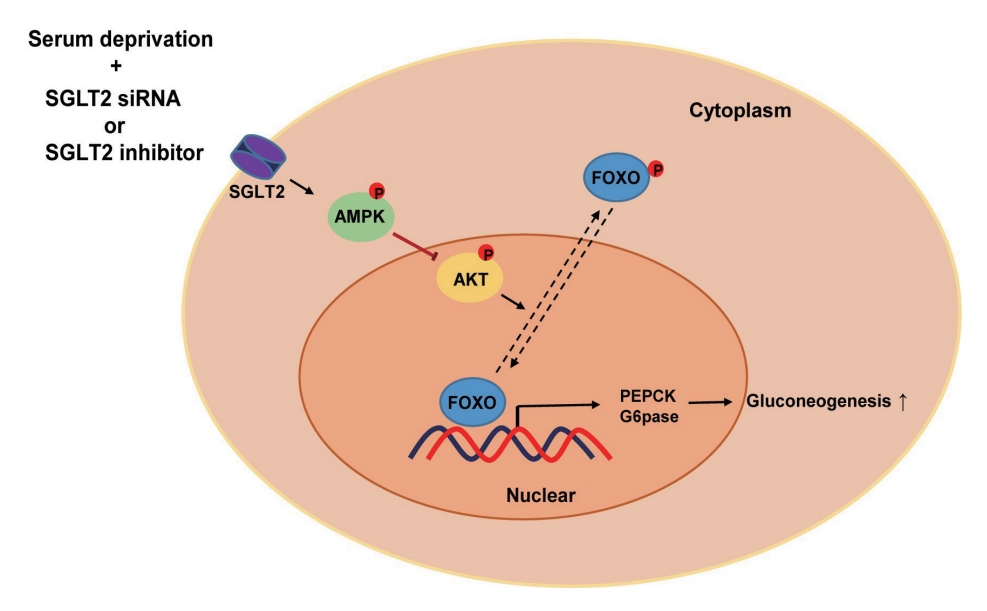Search
- Page Path
- HOME > Search
- Diabetes, obesity and metabolism
- Inhibition of Sodium-Glucose Cotransporter-2 during Serum Deprivation Increases Hepatic Gluconeogenesis via the AMPK/AKT/FOXO Signaling Pathway
- Jinmi Lee, Seok-Woo Hong, Min-Jeong Kim, Yu-Mi Lim, Sun Joon Moon, Hyemi Kwon, Se Eun Park, Eun-Jung Rhee, Won-Young Lee
- Endocrinol Metab. 2024;39(1):98-108. Published online January 3, 2024
- DOI: https://doi.org/10.3803/EnM.2023.1786

- 1,431 View
- 82 Download
-
 Abstract
Abstract
 PDF
PDF Supplementary Material
Supplementary Material PubReader
PubReader  ePub
ePub - Background
Sodium-dependent glucose cotransporter 2 (SGLT2) mediates glucose reabsorption in the renal proximal tubules, and SGLT2 inhibitors are used as therapeutic agents for treating type 2 diabetes mellitus. This study aimed to elucidate the effects and mechanisms of SGLT2 inhibition on hepatic glucose metabolism in both serum deprivation and serum supplementation states.
Methods
Huh7 cells were treated with the SGLT2 inhibitors empagliflozin and dapagliflozin to examine the effect of SGLT2 on hepatic glucose uptake. To examine the modulation of glucose metabolism by SGLT2 inhibition under serum deprivation and serum supplementation conditions, HepG2 cells were transfected with SGLT2 small interfering RNA (siRNA), cultured in serum-free Dulbecco’s modified Eagle’s medium for 16 hours, and then cultured in media supplemented with or without 10% fetal bovine serum for 8 hours.
Results
SGLT2 inhibitors dose-dependently decreased hepatic glucose uptake. Serum deprivation increased the expression levels of the gluconeogenesis genes peroxisome proliferator-activated receptor gamma co-activator 1 alpha (PGC-1α), glucose 6-phosphatase (G6pase), and phosphoenolpyruvate carboxykinase (PEPCK), and their expression levels during serum deprivation were further increased in cells transfected with SGLT2 siRNA. SGLT2 inhibition by siRNA during serum deprivation induces nuclear localization of the transcription factor forkhead box class O 1 (FOXO1), decreases nuclear phosphorylated-AKT (p-AKT), and p-FOXO1 protein expression, and increases phosphorylated-adenosine monophosphate-activated protein kinase (p-AMPK) protein expression. However, treatment with the AMPK inhibitor, compound C, reversed the reduction in the protein expression levels of nuclear p- AKT and p-FOXO1 and decreased the protein expression levels of p-AMPK and PEPCK in cells transfected with SGLT2 siRNA during serum deprivation.
Conclusion
These data show that SGLT2 mediates glucose uptake in hepatocytes and that SGLT2 inhibition during serum deprivation increases gluconeogenesis via the AMPK/AKT/FOXO1 signaling pathway.

- Partial Hepatectomy in Acetylation-Deficient BubR1 Mice Corroborates that Chromosome Missegregation Initiates Tumorigenesis
- Yoo-Kyung Lee, Inai Park, Hyunsook Lee
- Endocrinol Metab. 2014;29(4):561-566. Published online December 29, 2014
- DOI: https://doi.org/10.3803/EnM.2014.29.4.561
- 2,797 View
- 26 Download
- 2 Web of Science
- 3 Crossref
-
 Abstract
Abstract
 PDF
PDF PubReader
PubReader Background Aneuploidy has been suggested as one of the major causes of cancer from the time of Boveri. In support of this notion, many studies have shown that cancer cells exhibit aneuploidy. However, there are evidences that do not support the aneuploidy hypothesis. We have previously reported that the spindle assembly checkpoint protein BubR1 is acetylated in mitosis and that the acetylation of BubR1 is crucial for checkpoint maintenance and chromosome-spindle attachment. Mice heterozygous for acetylation-deficient BubR1 (
K243R /+) spontaneously develop cancer with chromosome instability. AsK243R /+ mice develop hepatocellular carcinoma, we set out to test if chromosome mis-segregation was the cause of their liver cancer.Methods Primary hepatocytes in the regenerating liver after partial hepatectomy (PH) were analyzed and compared for various mitotic parameters.
Results Primary hepatocytes isolated from
K243R /+ mice after PH displayed a marked increase of chromosome misalignment, accompanied by an increase of micronuclei. In comparison, the number of nuclei per cell and the centrosome numbers were not different between wild-type andK243R /+ mice. Taken together, chromosome mis-segregation provokes tumorigenesis in mouse liver.Conclusion Our results corroborate that PH provides a reliable tool for assessing mitotic infidelity and cancer in mice.
-
Citations
Citations to this article as recorded by- BubR1 controls starvation-induced lipolysis via IMD signaling pathway in Drosophila
Mengyou Liu, Shengye Yang, Jingsi Yang, Ping Feng, Feng Luo, Qiaoqiao Zhang, Li Yang, Hao Jiang
Aging.2024; 16(4): 3257. CrossRef - Loss of BubR1 acetylation provokes replication stress and leads to complex chromosomal rearrangements
Jiho Park, Song Y. Yeu, Sangjin Paik, Hyungmin Kim, Si‐Young Choi, Junyeop Lee, Jinho Jang, Semin Lee, Youngil Koh, Hyunsook Lee
The FEBS Journal.2021; 288(20): 5925. CrossRef - Articles in 'Endocrinology and Metabolism' in 2014
Won-Young Lee
Endocrinology and Metabolism.2015; 30(1): 47. CrossRef
- BubR1 controls starvation-induced lipolysis via IMD signaling pathway in Drosophila


 KES
KES

 First
First Prev
Prev



